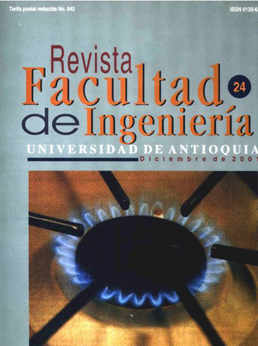Trampas para la adsorción de fósforo
DOI:
https://doi.org/10.17533/udea.redin.326325Keywords:
Envenenamiento fósforo, adsorción fósforo, aditivos aceites, paladio, mordenita, reducción catalítica selectiva, monolito.Abstract
Se investigó la capacidad de varios óxidos soportados en alúmjna, como: óxido de níquel (NiO), de cobre (CuO), de cobalto (Co2O3), de cerio (CeO2), de bario (BaO) y de cinc (ZnO), para adsorber trazas de fósforo (P). El óxido de cinc (ZnO) soportado en alúmina mostró la mayor capacidad de retención de P. Sin embargo, cuando dicho adsorbente se usa como recubrimiento del catalizador 0,3% Pd-H-MOR para la reducción catalítica selectiva (RCS) de NOx con metano, la actividad disminuye. Por tanto, no es recomendable usar dicho adsorbente como recubrimiento del catalizador, sino que debería ubicarse corriente arriba del catalizador. Entre los procedimientos para la remoción de fósforo del adsorbente, el lavado de ZnO/yAl2O3 con ácido cítrico, permitió remover más del 70% de fósforo sin afectar la estructura del adsorbente.
Downloads
References
Williamson. W. el al. "Effects of oil phosphorus on deactivation of monolithic three-way catalysts". En: Applied Catalysis B: Environmental. Vol. 15. 1985.p. 277. DOI: https://doi.org/10.1016/S0166-9834(00)81842-4
Darr. S. et al. "Effects of oil-derived contaminams on emissions from two-equipped vehicle s". En: SAE Technical paper series No. 20-01-1881. Junio. 2000. DOI: https://doi.org/10.4271/2000-01-1881
Williamson. W. et al. "Catalyst deactivation due to glaze formation from oil-derived phosphorus and zinc". En: SAE Technical paper series No. 841406. 1984. DOI: https://doi.org/10.4271/841406
Farrauto, Robert. et al. "A catalytic trap regenerable. Method for use". Patente US No. 5792436. Agosto, 1998.
Beck D. et al. "Axial characterization of cataytic activity in close-coupled lightoff and underfloor catalytic converters'". En: Applied catalysis B: Envirnmental. Vol. 1. 1997.p. 257. DOI: https://doi.org/10.1016/S0926-3373(96)00050-1
Angelidis T. et al. "Partial regeneration of an aged commercial automotive catalyst". En: Applied catalysis B: Environmental. Vol. 2. 1997. p. 193. DOI: https://doi.org/10.1016/S0926-3373(96)00067-7
Downloads
Published
How to Cite
Issue
Section
License
Revista Facultad de Ingeniería, Universidad de Antioquia is licensed under the Creative Commons Attribution BY-NC-SA 4.0 license. https://creativecommons.org/licenses/by-nc-sa/4.0/deed.en
You are free to:
Share — copy and redistribute the material in any medium or format
Adapt — remix, transform, and build upon the material
Under the following terms:
Attribution — You must give appropriate credit, provide a link to the license, and indicate if changes were made. You may do so in any reasonable manner, but not in any way that suggests the licensor endorses you or your use.
NonCommercial — You may not use the material for commercial purposes.
ShareAlike — If you remix, transform, or build upon the material, you must distribute your contributions under the same license as the original.
The material published in the journal can be distributed, copied and exhibited by third parties if the respective credits are given to the journal. No commercial benefit can be obtained and derivative works must be under the same license terms as the original work.










 Twitter
Twitter